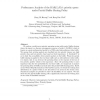Free Online Productivity Tools
i2Speak
i2Symbol
i2OCR
iTex2Img
iWeb2Print
iWeb2Shot
i2Type
iPdf2Split
iPdf2Merge
i2Bopomofo
i2Arabic
i2Style
i2Image
i2PDF
iLatex2Rtf
Sci2ools
COR
2004
2004
Performance analysis of the DAR(1)/D/c priority queue under partial buffer sharing policy
We analyze a multi-server priority queueing system with partial buffer sharing, where the input is a discrete autoregressive process of order 1 (DAR(1)) which is known as a good mathematical model for a VBR-coded teleconference video traffic. We assume that arriving packets are classified into two priority classes, say, high priority class and low priority class based on their importance. A threshold T is set to limit the accessibility of low priority packets to the buffer. When the partial buffer sharing is applied to the real time traffic such as teleconference video traffic, it is known that it can decrease the queueing delay at the expense of the loss of low priority packets which is less important. Since the queueing delay is more important than the loss probability for real time traffic, it is important to analyze the queueing delay of DAR(1) arrivals under the partial buffer sharing policy. Based on the Wiener-Hopf factorization of the GI/GI/1 queue, we obtain the waiting time ...
| Added | 17 Dec 2010 |
| Updated | 17 Dec 2010 |
| Type | Journal |
| Year | 2004 |
| Where | COR |
| Authors | Gang Uk Hwang, Bong Dae Choi |
Comments (0)

